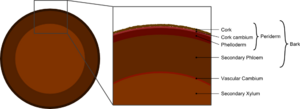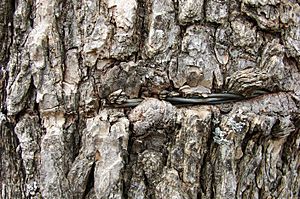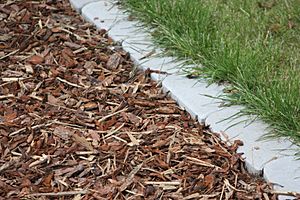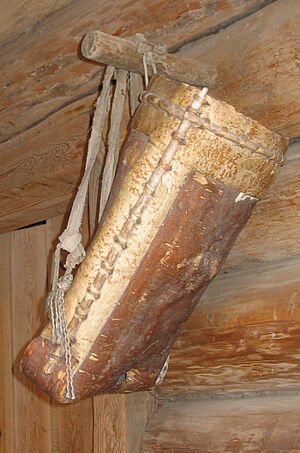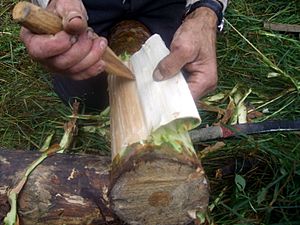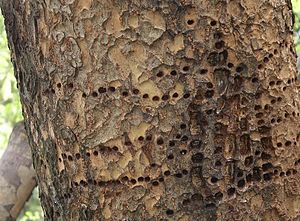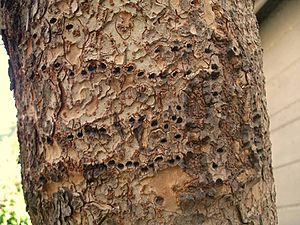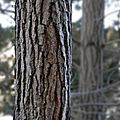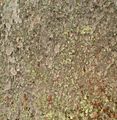Bark facts for kids
Bark is like the skin of a tree or other woody plant. It covers the outside of the stems and trunks. Bark is very important because it protects the tree from many things. It keeps the tree safe from disease, insects, and even fire.
Bark can look very different from one tree to another. Some bark is rough and bumpy, while other bark is smooth. It also comes in many different colors.
Most of the bark grows from a special layer inside the tree called the vascular cambium. Some outer parts of the bark grow from another layer called the cork cambium. These layers help the tree grow bigger and stronger.
Plants with bark include trees, woody vines, and shrubs. Bark is a general term for all the tissues found outside the vascular cambium. It covers the wood and has two main parts: the inner bark and the outer bark. The inner bark is alive in older stems. The outer bark is mostly dead tissue on the surface.
Many useful things come from bark. These include spices like cinnamon, medicines, and cork. People have also used bark to make cloth, canoes, and ropes. It has even been used for paintings and maps! Some trees are grown just because their bark is so beautiful.
Contents
What is Bark Made Of?
Bark is actually made of several different types of tissues. One important part is called the cork. Cork is the outer layer that keeps water and gases from getting in or out. It is made by the cork cambium, which is a layer of active cells. These cells constantly divide to make new cork.
The cork cambium is usually very thin, only one cell thick. Sometimes, another layer of cells called the phelloderm forms inside the cork cambium. Together, the cork, cork cambium, and phelloderm make up the periderm.
Cork cells have a waxy substance called suberin in their walls. This waxy layer protects the stem from losing water. It also stops insects from getting in and prevents infections from tiny bacteria and fungal spores.
The cambium layers are the only parts of a woody stem where new cells are made. The vascular cambium makes new xylem (which carries water) and phloem (which carries nutrients). Phloem is the inner bark. It moves food made by the leaves to other parts of the tree.
When a tree is young, its stem has an outer layer called the epidermis. As the stem gets older and grows, the epidermis is replaced by the bark. The cork layers become thicker. Cells that are outside these thick cork layers die because they can no longer get water and nutrients. This dead layer is the rough, corky bark you see on tree trunks.
The Periderm: A Protective Layer
The periderm is a secondary covering that forms on woody stems. It is made of cork, the cork cambium, and the phelloderm. The periderm replaces the epidermis as the main protective covering.
Mature cork cells have suberin in their walls. This helps protect the stem from drying out and from attacks by harmful organisms. Older cork cells are dead. For example, the skin on a potato is actually the cork of its periderm.
As a tree stem grows, the cork cambium creates new layers of cork. These new layers are waterproof and airtight. This means that the old outer layers of the stem, like the epidermis and cortex, die off because they can't get what they need.
Within the periderm, there are small openings called lenticels. These are like tiny pores. They allow living cells inside the bark to exchange gases with the air outside. As the bark grows, new lenticels form in the cracks of the cork layers.
Rhytidome: The Outer Bark
The rhytidome is the part of the bark that most people recognize. It is the rough, outer layer that covers tree trunks. It is mostly made of dead cells. This layer forms as many layers of cork, cortex, and phloem tissue build up. The rhytidome is usually thickest and most unique at the bottom part of the tree trunk.
How We Use Bark
Cork is the very outermost layer of a woody stem. It protects the tree from damage, like from parasites, animals that eat plants, and disease. It also helps prevent the tree from drying out or catching fire easily. Cork can contain special chemicals called tannins. These tannins act like antiseptics, protecting against fungal and bacterial attacks that could cause the tree to rot.
Some trees have very thick bark. This extra thickness gives them even more protection. It also makes their bark look very unique, often with deep ridges. For example, the Cork oak tree has bark so thick that it can be harvested to make cork products without harming the tree. Its bark can grow more than 20 centimeters thick!
The smooth bark of birch trees can be peeled off in long sheets. People have used birch bark to make canoes, roofs, shoes, and backpacks. The famous birch canoes of North America are a great example.
The inner bark (phloem) of some trees can even be eaten! In northern Europe, people used to make "bark bread" by adding ground inner bark from Scots pine or birch to rye flour. The Sami people in northern Europe used large sheets of Scots pine bark as a main food source. They would eat the inner bark fresh, dried, or roasted.
Bark Products and Uses
Bark contains strong fibers called bast. For a long time, people in northern Europe used bark from young Small-leaved lime trees to make ropes and cords. These ropes were even used on Viking age longships!
Other commercial products from bark include cinnamon, quinine (from the bark of Cinchona trees), and aspirin (from willow trees). The bark of some trees, like oak, is a source of tannic acid. This acid is used in tanning to make leather.
When trees are cut for lumber, the bark is often removed. These bark chips are then used as mulch in gardens. Bark is also important for growing certain plants, like epiphytes, which don't grow well in regular soil.
Scientists are also finding new uses for bark. For example, bark has a substance called lignin. When bark is heated without oxygen, it creates a liquid called bio-oil. This bio-oil is rich in natural chemicals that can replace fossil-based chemicals. These can then be used to make glues for wood products like OSB and plywood.
Bark Repair
Trees can sometimes repair damage to their bark. How well they heal depends on the type of tree and how bad the damage is. Some trees can quickly grow new tissue called a callus. This callus grows over the wound, leaving a clear scar. Other trees, like oaks, don't grow as much callus.
Frost cracks and sun scald are common types of bark damage. Trees can repair these to some extent, depending on how severe they are.
Images for kids
See also
 In Spanish: Corteza (desambiguación) para niños
In Spanish: Corteza (desambiguación) para niños



